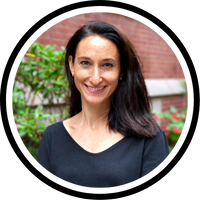|
In order to succeed, students need to practice connecting and empathizing with others.
As I sit here at my computer, I could also be video chatting with a relative in Argentina while checking airfare prices, ordering pizza to be delivered in an hour, checking the weather for next weekend, finding an inspirational quote to add to my workshop tomorrow, and checking who the seven dwarves are because it’s been bugging me. And the funny part is, none of this would seem unusual to you! With a smartphone or computer and a good wifi connection, knowledge and information is a click away. Watching my own children attend school from home this past year gave me insight into how much technology is affecting schoolwork. Yes, they are still doing math, still reading, still writing, but there is also this: “Alexa, how do you spell “suggestion?” “Alexa, which fraction is larger- ⅔ or ¾?” Yikes!
When we think about the future, we tend to imagine the remarkable technology that will continue to develop. And so, when thinking about what skills our students need to thrive in the 21st century, the gut response is more tech skills, more computer savviness. But acquiring more tech skills can only get us so far. What students need is the ability to think critically, and the ability to collaborate with diverse thinkers. To do this, our students need to be taught how to connect and empathize with others.
Teaching empathy
When I think about students who have really stood out to me, from middle school to graduate school, I think of the students who could work with anyone — the ones that helped their classmates shine bright. Those are the students I remember the most. I’d like to make a case that it is possible to teach this, or put structures in place to teach students to think outside of themselves. To teach students the importance of getting along with others, and seeing the world from another point of view. In a recent speech by President Joe Biden, he urges Americans to practice empathy for the health of our country. He reasoned: “For empathy is the fuel of democracy. Let me say that again: Empathy — empathy is the fuel of democracy, a willingness to see each other — not as enemies, neighbors. Even when we disagree, to understand what the other is going through.” That ability to see “what the other is going through” is something we can teach. And as President Biden points out, this quality that may have once been thought of as a soft skill is one that we need to fuel our democracy. One way to “understand what the other is going through” is through reading. While I am not an immigrant, I can dive into the lives of Jhumpa Lahiri’s characters in The Namesake and experience Ashima’s deep loneliness in Cambridge, longing for her family, feeling like a foreigner. I can also experience her delight when she realizes she can recreate her favorite street snack from Calcutta — a mixture of peanuts, Rice Krispies, onions, and spices. As a teacher reading The Namesake in an English or Humanities class, I would invite students to sit with Ashima for a while. Live in her loneliness a bit, stew in the feeling of everything feeling unfamiliar. Offer students a choice for how they can engage with the characters, such as:
There are so many ways to empathize with characters in English or Humanities classes, through reading, writing, and discussions.
Connecting to content areas
In an interview with Life Magazine, James Baldwin explains, “You think your pain and your heartbreak are unprecedented in the history of the world, but then you read. It was books that taught me that the things that tormented me most were the very things that connected me with all the people who were alive, who had ever been alive.” Baldwin reminds us all what it means to be human, and through literature we can feel each other’s pain, knowing we, too, have experienced the same. While the particulars may be different, we all have hard moments of hardship that have “tormented” us in some way. But how do we explore this in subject areas other than English or Humanities? Or for students who may not be able to empathize in such a way? For content area classes, Facing History offers a tool to help students forge a connection with something they have read or are exploring.
Using this tool invites students to spend time thinking, probing, and considering how an event or problem is relatable in some way. Facing History suggests using these prompts with the chart above (available for download here):
Students can easily use this tool in History or Science, as they are learning about scientific discoveries or ethical dilemmas involved in scientific explorations. If we want to help our students become 21st century thinkers, we have to create scenarios in which they are stepping outside of themselves, extending into another’s world in some way. This is what will help students build ideas together. This is what will make our students think more complexly.
Our equations can always be situated in the real world, which offers our young people another perspective. Another way to teach empathy in all subject areas is to normalize students helping each other, teaching one another, and working together to solve problems. Teaching students how to teach their classmates signals to them that you value collaboration, and that the ability to teach and work together are significant, valued characteristics. Encouraging students to step into a teaching role will also help them gain a greater awareness of the topic at hand — when students take on the qualities of a teacher, they are not only learning how to work with their classmates, but simultaneously becoming more of an expert on the subject.
Technology will continue to develop at a rapid pace, and knowledge will continue to be accessible to all of us. Creating situations where students learn to step outside of themselves is what will propel our students into more complex and critical ways of thinking. We must continue to focus on how we can help our students think about each other and our world, and encourage them to collaborate and share ideas. As President Biden put it, this is what fuels our democracy. This is how we will stay 21st century ready.
|
|
The Center for Professional Education of Teachers (CPET) at Teachers College, Columbia University is committed to making excellent and equitable education accessible worldwide. CPET unites theory and practice to promote transformational change. We design innovative projects, cultivate sustainable partnerships, and conduct research through direct and online services to youth and educators. Grounded in adult learning theories, our six core principles structure our customized approach and expand the capacities of educators around the world.
|
ABOUT US
525 West 120th Street, Box 182 New York, NY 10027 416 Zankel Ph: (212) 678-3161 [email protected] Our Team Career Opportunities |
RESOURCES
Professional Articles Ready-to-Use Resources Teaching Today Podcast Upcoming PD Opportunities |
COACHING SERVICES
Custom Coaching Global Learning Alliance Literacy Unbound New Teacher Network Student Press Initiative |



























